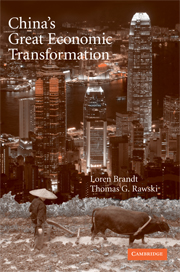Book contents
- Frontmatter
- Contents
- List of Figures
- List of Tables
- Contributors
- Acknowledgments
- Map
- 1 China's Great Economic Transformation
- 2 China and Development Economics
- 3 China in Light of the Performance of the Transition Economies
- 4 A Political Economy of China's Economic Transition
- 5 The Demographic Factor in China's Transition
- 6 The Chinese Labor Market in the Reform Era
- 7 Education in the Reform Era
- 8 Environmental Resources and Economic Growth
- 9 Science and Technology in China
- 10 The Political Economy of Private Sector Development in China
- 11 The Role of Law in China's Economic Development
- 12 China's Fiscal System: A Work in Progress
- 13 Agriculture in China's Development: Past Disappointments, Recent Successes, and Future Challenges
- 14 China's Financial System: Past, Present, and Future
- 15 China's Industrial Development
- 16 China's Embrace of Globalization
- 17 Growth and Structural Transformation in China
- 18 Income Inequality during China's Economic Transition
- 19 Spatial Dimensions of Chinese Economic Development
- 20 Forecasting China's Economic Growth to 2025
- Index
5 - The Demographic Factor in China's Transition
Published online by Cambridge University Press: 24 May 2010
- Frontmatter
- Contents
- List of Figures
- List of Tables
- Contributors
- Acknowledgments
- Map
- 1 China's Great Economic Transformation
- 2 China and Development Economics
- 3 China in Light of the Performance of the Transition Economies
- 4 A Political Economy of China's Economic Transition
- 5 The Demographic Factor in China's Transition
- 6 The Chinese Labor Market in the Reform Era
- 7 Education in the Reform Era
- 8 Environmental Resources and Economic Growth
- 9 Science and Technology in China
- 10 The Political Economy of Private Sector Development in China
- 11 The Role of Law in China's Economic Development
- 12 China's Fiscal System: A Work in Progress
- 13 Agriculture in China's Development: Past Disappointments, Recent Successes, and Future Challenges
- 14 China's Financial System: Past, Present, and Future
- 15 China's Industrial Development
- 16 China's Embrace of Globalization
- 17 Growth and Structural Transformation in China
- 18 Income Inequality during China's Economic Transition
- 19 Spatial Dimensions of Chinese Economic Development
- 20 Forecasting China's Economic Growth to 2025
- Index
Summary
During the last two and a half decades, China has witnessed demographic change of historic proportions. It has transformed from a “demographic transitional” society, one where reductions in mortality led to rapid population growth and subsequent reductions in fertility led to slower population growth, to a “post transitional” society, where life expectancy has reached new heights, fertility has declined to below-replacement level, and rapid population aging is on the horizon. In the not-too-distant future – in a matter of a few decades – China's population will start to shrink, an unprecedented demographic turn in its history in the absence of massive wars, epidemics, and famines. In this process, China will also lose its position as the most populous country in the world.
Demographic changes in China are monumental for reasons in addition to the shifts in traditional demographic parameters – mortality, fertility, population growth rate, and age structure. During its economic transitions of the last two and a half decades, China has also seen migration and urbanization processes that are unprecedented in world history for their sheer magnitudes. Population redistribution is inextricably tied to the broad social and economic transitions that China has undergone, and at the same time, it has also shaped important underlying conditions, as opportunities and constraints, for China's economic transition.
At the start of China's economic reform in the late 1970s, the post-Mao Chinese leadership established population control as one of its top policy priorities.
- Type
- Chapter
- Information
- China's Great Economic Transformation , pp. 136 - 166Publisher: Cambridge University PressPrint publication year: 2008
- 11
- Cited by



